


This extraordinary painting of Fra Luca Paccioli, shown below, painted by J de Barbari (1440 -1516) gives us a historical summary of many fascinating elements of the Golden Proportion under the following five headings.

The painting shows Paccioli (5) with an intense gaze on the suspended solid transparency (3) relating it to a text and a drawing on a slate (2) showing Euclid’s name.
The transparent figure that Fra Luca Paccioli is studying is a composite of the platonic solids (3).
The pentagon is a 5 sided figure (Penta meaning 5.) It is seen in the painting as the surface of the dodecahedron which is one of the Platonic solids. The famous building, the pentagon which is the seat of government in the USA is built in this shape. Inscribed within is the 5-pointed star, a pentagram, frequently seen in military ensignia. Superimposed on this pentagram is a golden proportion gauge showing a smaller to larger division of the Golden Proportion on a line (a chord) of the pentagon as seen below.
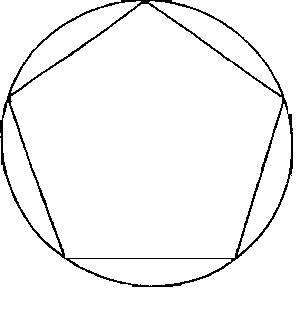

The ancient Greeks, starting with Pythagoras in about 550 BCE, were very interested in the way the the diagonals of the pentagram (the 5 pointed star) intersect each other in the golden proportion and gave the first formulation of the golden proportion in the following terms.
” The diagonals of the pentagram cut each other in division of extreme and mean ratio”
This latter expression is the inspired title of a book by Roger Hertz-Fischler printed in 1987 in which he traces the history of the Golden Proportion in great detail. The book ranges from ancient Greece across the globe, embracing many different cultures and, from the time of Pythagoras, to the modern day.
Huntley in his book The Divine Proportion [Dover 1970] describes the reverence which the ancient Greeks felt for the Golden Proportion as symbolized in the Pentagram. They felt that it had a mystical significance and revered the pentagram as the symbol of their secret society. The Pythagoreans were both fascinated and perplexed by the intersecting cords of the Pentagon giving a double Golden Mean Proportion, details of which are described under, “what’s special“.

The bottom left of Pacioli’s painting, shows a slate with Euclids’s name. Pacioli seems to be relating the text he is reading to the Slate with Euclid’s name on it. The slate probably refers to Euclid’s treatise of thirteen books on Geometry which he called “The Elements”. Completed in Alexandria in 300 BCE, it is still considered to be the best book ever written on elementary mathematics or ever likely to be written (Coxeter 1980) .

His treatise “the Elements” laid the foundation for the PLATONIC SOLIDS which represent the culmination of the discoveries that marked the epic age of Greek Mathematics. Euclid in 300BCE, put the finishing touches to the theory of the Golden Proportion and showed how to construct the Golden Proportion with compass and ruler only.
There seems to be no doubt that Greek architects and sculptors incorporated this ratio in their artifacts. The proportions of the Parthenon shows the way the Greeks deliberately used the Golden Proportion (Huntley, 1970). In the early days of the present century, it was suggested that the Greek letter ‘phi’,![]() , the initial letter of Phidias’ name, who was one of the ancient Greek famous Sculptors, would be adopted to designate the Golden Proportion.
, the initial letter of Phidias’ name, who was one of the ancient Greek famous Sculptors, would be adopted to designate the Golden Proportion.
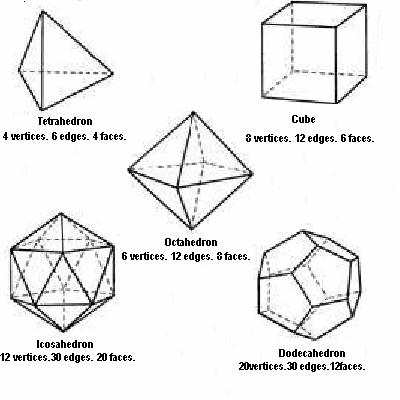
The transparent figure that Fra Luca Paccioli,in the HISTORY page, is studying is a composite of the platonic solids. The 5 Platonic solids are illustrated above with some of their properties. Euclid, 300 BCE and the Ancient Greeks, in their love for geometry, called these five solids, the atoms of the Universe. In the same way that we today believe that all matter, is made up of combinations of atoms so the Ancient Greeks (also) believed that all physical matter is made up of the atoms of the Platonic Solids and that all matter also has a mystical side represented by their connection with earth, air, fire, water and aether. Similar to our modern atom which shows a nucleus surrounded by electrons in orbits creating spheres of energy, the Greeks felt that these Platonic solids also have a spherical property, where one Platonic Solid fits in a sphere, which alternately fits inside another Platonic Solid, again fitting in another sphere. Paccioli is studying in a transparency the way in which one solid fits inside another. The concept of one sphere fitting inside another sphere is surprisingly frequently seen in different cultures but manifesting in uniquely different ways, as will be accurately described in the author’s forth coming book.
The Pythagoreans knew that there were only five regular convex solids, the tetrahedon, cube, octahedron, icosohedron and dodecahedron and each one could be accurately circumscribed by a sphere. The dodecahedron had twelve regular faces, which corresponded to the twelve signs of the Zodiac; it was therefore a symbol of the universe for the Pythagoreans. Moreover, each one of these faces is a pentagon. Euclid described these five regular solids in Book Thirteen of the Elements. They are associated with the name of Plato because of his efforts to relate them to the important entities of which he supposed the world to be made. Plato discusses them in his various dialogues.
The corners of the octohedron fit in the centre of thr cube faces. The icosohedron can be inscribed in an octohedron, so that each vertex of the former divides an edge of the latter into the Golden Proportion The icosohedron and the dodecohedron are also uniquely connected with the Golden Proportion by virtue of three intersecting golden rectangles which fit into both. In modern times it has been discovered that the shape of many of the viruses is either icosohedron or cube.
The pentagon (the five-sided figure) is closely related to the icosohedron and its complement the dodecohedron. The diagram shows clearly how the dodecahedron is made up of twelve pentagonal faces. The Icosohedron is made up of triangular faces, but also grouped in 5 as seen at the vertex where 5 triangular faces come together.
Whereas these later 2 mentioned platonic solids are seen in the 5 pointed star the remaining three platonic solids can be found in the 6 pointed star.
The dodecahedron is one of the 5 Platonic solids with 12 pentagonal surfaces.
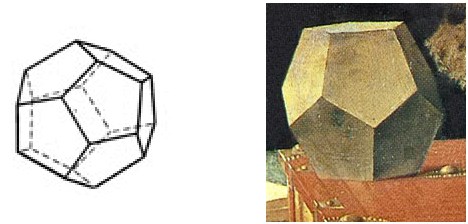
 One of the 5 platonic solids is described by Plato in the “The Phaedo” (110 B.) where he refers to a ball with 12 pentagonal faces and which is the precursor to our modern football, still made with a variable number of pentagons as shown in the adjacent photograph.
One of the 5 platonic solids is described by Plato in the “The Phaedo” (110 B.) where he refers to a ball with 12 pentagonal faces and which is the precursor to our modern football, still made with a variable number of pentagons as shown in the adjacent photograph.
The dodecahedron contain 3 Golden Proportion intersecting rectangles, as seen in the adjacent diagram. This later theme has inspired the Laban School of Dancing to base its movements within the rectangles.
The icosahedron fits well as an inscribed solid within the dodecahedron.

The platonic solids and the Golden Proportion underwent a revival during the Renaissance as shown in the painting by J. De Barbari, of Fra Luca Paccioli. This painting illustrates 5 different facets of the Golden Proportion.
A copy of a painting of Fra Luca Paccioli, studying The Platonic Solids and Euclid’s work, has been used as the front cover of Robert Lawlor’s book “Sacred Geometry – Philosophy and Practice”, which contains two excellent chapters on the Golden Proportion. This painting has also been included in an article on dental aesthetics written by the author in the USA journal of Prosthetic Dentistry Sep 1978 and Dental Aesthetics Indepentent Dentistry. London The Golden Proportion Jan 1997.
Leonardo da Vinci, together with his mentor, Fra Luca Paccioli, one of the leading scientists and mathematicians of the Renaissance, were both fascinated with the Golden Proportion and together wrote a dissertation on the golden Proportion. The dissertation was printed in 1509 under the title of the Divine Proportion”, reprinted in Milan in 1896, (Gardner Pelican 1961), the frontispiece of which is shown below.
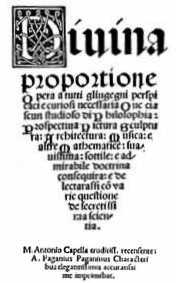
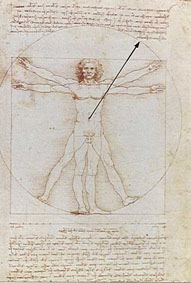
Amongst Da Vinci’s abundant studies is his famous squaring of the circle. So fascinating that variation have become the logo of a number of organisations, each with slight modifications. It shows the figure of a man contained within a square as well as within a circle. Its connection with the Golden Proportion is that the centre of the circle is in the umbilical navel which divides the body into a larger part and a smaller upper part, the two parts in the Golden Proportion’ as in the above copy of the study.